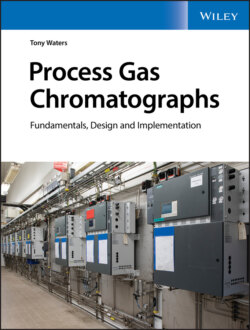Читать книгу Process Gas Chromatographs - Tony Waters - Страница 33
Knowledge Gained
ОглавлениеChromatography is a general method of separation and includes many different practical techniques.
Chromatography uses a fluid mobile phase passing over a liquid or solid stationary phase.
In gas chromatography, the mobile phase is gas; in liquid chromatography, the mobile phase is liquid.
Chromatographic analyzers separate the desired analytes and then measure them one by one.
Other analyzers attempt to measure the analyte molecules in the presence of other molecules.
Gas chromatographs inject a tiny volume of sample into the flowing carrier gas.
The sample must be a gas or a volatile liquid that quickly vaporizes and enters the column as a vapor.
In the laboratory, sample injection is by glass syringe, either manual or by an autosampler.
Process gas chromatographs (PGC) use an automatic injection valve to inject the sample.
The carrier gas carries the sample into the column where it contacts the stationary phase.
The stationary phase may be a solid adsorbent or an immobilized non‐volatile liquid.
Contact with the stationary phase delays some peaks more than others, so separation occurs.
Special routing valves may direct the peaks into different columns to finish the desired separation.
PGCs can now use either packed columns or capillary (open‐tubular) columns.
The separation process takes time; typically one to ten minutes, sometimes longer.
The carrier gas elutes peaks from the column into a chosen detector for measurement.
The detector responds to a property of analyte molecules that differs from carrier gas molecules.
The TCD, FID, and FPD are popular detectors in process gas chromatographs.
The detector output signal forms a chromatogram display when plotted against elapsed time.
Analyte molecules cluster together at different times to form separate chromatogram peaks.
The PGC may measure peak area or peak height to compute the concentration of an analyte.
The PGC uses stored calibration factors to calculate the concentration of each analyte.
The chromatogram is a most valuable source of information, but one must learn to read it.
To the expert troubleshooter, all chromatographic faults are visible on the chromatograms.
